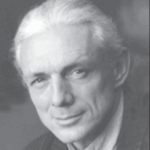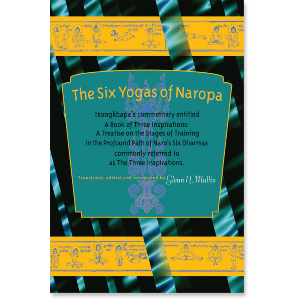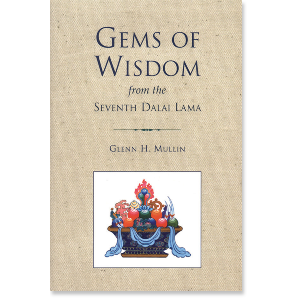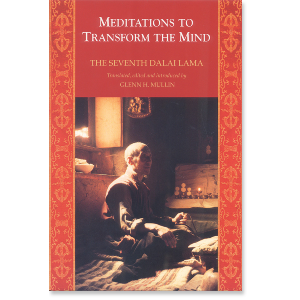Tibetan Museum Society: Could you tell us something about your personal background, and how it was that you began your journey as a Tibetologist, Buddhist writer, translator and meditation teacher?
Glenn Mullin: In terms of the facilitating conditions of this lifetime, my mother was British and claimed that we were descended from Sir Francis Bacon, who wrote the Shakespeare plays. She always stressed that her children should look for less trodden paths, and for ways to make a contribution to world civilization, rather than make job or career the priorities. I suppose in that sense she was something of a bodhisattva.
Years later, when I wrote from India that I had met the Dalai Lama she replied saying, “Even if you die tomorrow, you have brought a greater honor to this family than could ever have been imagined.” She wasn’t a Buddhist, but somehow instinctively knew that the Dalai Lama was a great man.
TMS: In addition to sharing with the world your travels and insights on Tibetan spiritual culture, you also reveal to us the sacred art of the region.
GM: I fell in love with Buddhist art in my youth, and became intimately involved with it in my early days in Dharamsala. Our school there at the Tibetan Library also had a great museum.
In addition, I happened to live across the street from Jampa-la, one of the Dalai Lama’s main artists. He also was the only art master in Dharamsala who accepted Western disciples. Because I lived across the street from him, I was asked to come over and translate several times a week for visiting students. Generally he would give them a task, supervise them at it for a few hours, and then send them away to work on it themselves for a few weeks.
I was able to learn a lot from these sessions. Of course many of those students knew a lot on art history, identification, cross fertilization of influences through the Silk Road, the anthropology of pigments, and many subjects that Tibetan painters rarely think of, so in a sense I learned almost as much from them as I did from him. That said, he really did embody the enlightenment qualities of a master artist as well as anyone I have ever met before or since. He was an exceptional man and teacher.
A serious problem these days is that a lot of Mongolian Buddhist art is being taken to China and Hong Hong, where it is sold as Tibetan. Tibetan art brings four or five times what Mongolian art does, because of the popularity of Tibet and the Dalai Lama.
This practice of purposely misrepresenting the source of the art in order to gain a greater profit is very disconcerting. It could have a devastating effect on how art history is written.
I would say that as much as 25% of all art sold as Tibetan in the last fifteen years is in fact Mongolian. And of course once a Mongolian painting is published in an art book and described as Tibetan, all pieces with the same characteristics that surface in future will be similarly misidentified in exhibitions and publications.
TMS: Some time after the opening of an exhibit you curated, “The Flying Mystics in Tibetan Buddhism,” you were quoted as saying, “Paranormal abilities of this nature are considered secondary to the primary goal of Tantric Buddhism, which is the inner realization of mahamudra.” Can you further explain the complexities of such philosophical realizations?
GM: Some of the curators at the Rubin Museum had argued against the “Flying Mystics” theme, because usually the flyers are shown as small vignettes in the background of a painting, as opposed to the central image. To me this is part of the charm of the exhibit, and not a flaw in it.
Buddhism always stresses inner accomplishment over external show. Thus in both Buddhist art and literature the performance of miraculous demonstrations is given a back seat to the inner miracle of enlightenment, which in tantra is called mahamudra. That said, Buddhist sages throughout the centuries have stepped out and spread their wings a bit from time to time. Buddha flew on numerous occasions, as did his two main disciples Shariputra and Maudgalyayana, as well as numerous members of the Sixteen Arhats. Then there was Nagarjuna, who seemed strained to keep his feet on the ground; and Asanga, who flew on a regular basis after his twelve year retreat. Shantideva continued the tradition by levitating out a window and disappearing in front of five hundred gaping monks.
Tibet, Bhutan and Mongolia very much continued the tradition, with Padma Sambhava, Yeshey Tsogyal, Namkha Nyingpo, Marpa, Milarepa, Machik Labdon and so forth.
Flying has always been big with the Mongolians. Back in the eleventh century, when the female mystic Machik Labdon was making waves in Tibet and the stories of a beautiful woman meditating naked in the snow mountains filtered down to India, the Nalanda abbot decided to send two monks to test the validity of her enlightenment. The only Nalanda monks who could fly were two Mongols, so he sent them. Paintings of Machik often depict one or both of these flying Mongols somewhere in the upper corners of the canvas.
TMS: I understand that you have studied philosophy, literature, meditation, yoga, and other such matters of enlightenment under thirty-five masters of Tibetan Buddhism. Is it possible to share with us who may have been your most influential mentor?
GM: I felt a deep connection to Buddhist literature from my childhood. I grew up in a small town in French Canada, but my mother always kept an international library. Her books on Asian spiritual culture fascinated me. Her dad had been a major in the British army in India, and she deeply loved all things Asian.
As a young man I moved to London, and while there I heard that the Dalai Lama was opening a Buddhist school in Dharamsala for Western students. I packed my bags and went.
I suppose the most impressive masters in my early days of Buddhist training were Kyabje Ling Rinpoche and Kyabje Trijang Dorje Chang, the two gurus of the Dalai Lama. They were the sun and moon of the Yellow School in India. All of us in those days received most of our major Tantric initiations from them. When they died in the early 1980s, the light of the world went markedly dim, and still has not come back to its full radiance.
Of course they were very old by then and did not do the work of the daily instructions. The Dalai Lama had appointed two great gesheys to teach to do this: Geshey Dargyey and Geshey Rabten. The enlightenment tradition shone in both of these men with an amazing clarity. They gave us our line-by-line readings of all the principal Indian Buddhist treatises, unpacking the meanings and bringing the texts into living experience. Lama Yeshey and Lama Zopa also came to Dharamsala twice a year in those days, and their main guru, Kyabje Trijang Rinpochey always pressed them into teaching us when they were there. Lama Yeshe had the most powerful public persona of anyone I ever met. It was hard to look at him without feeling like you were in the center of an earthquake.
Lamas of all schools came to Dharamsala to meet with the Dalai Lama, and he always had them give initiations and teach for a few days. Thus we were able to receive teachings and initiations from the heads of all the schools: Sakya Trizin, Karmapa, Dilgo Khyentsey, Drigung Chetsang, and many more. In addition, every winter we would all go down to Bodh Gaya or Sarnath, where lamas from all schools would come to escape the snows of the mountains. Naturally while there they would give teaching and initiations. I especially appreciate the links I established on those occasions with Kalu Rinpoche, Tai Situ Rinpoche, and Beru Khyentsey Rinpochey, all of whom represent the Karma Kargyu tradition.
During my Dharamsala days I developed a very strong relationship with the Nyingma lama Ngakpa Yeshey Dorje and his consort, Jetsunma Tenzin Dolkar. Both of them are wonderful examples of Buddhist practice and dedication. Their influence on my life has been very rewarding. In addition, I loved to go to Tashi Jong, where the great Khamtrul Rinpochey used to teach and give initiations. This great master really embodied the full range of realizations of the Drukpa Kagyu lineage.
After Kyabje Ling Rinpoche and Trijang Dorje Chang passed away I met the great Mongolian lama Lharam Geshey Sengey. From that time onward I mainly relied upon him and Denma Lobchu Rinpochey, the main Dharma Heir of both Kyabje Ling Rinpochey and Kyabjey Trijang Dorjey Chang.
Of course throughout all these years the Dalai Lama gave numerous teachings and initiations on an annual basis. Some years we would receive five or six hours of teachings from him a day for a month or more at a time. These were always very exciting and rewarding intensives. He usually taught for a few weeks in both spring and autumn, and then in mid-winter would do a few more weeks in somewhere warm, either Bodh Gaya or South India. The smaller events in his private temple in Dharamsala—not Namgyal but inside his residence—were especially engaging.
He usually gave one of these once a year to a select monastery. Other than that monastery only gesheys and tulkus were allowed to attend. In the mid-1970s I petitioned him directly and pointed out that this policy of qualifications for attendance was not fair and was in fact somewhat racist, because it automatically excluded all of us Westerners; no Westerner had been allowed to sit for a geshey exam at that time, nor had any been recognized as a tulku.
The Dalai Lama laughed and replied, “Then I guess we’ll have to open the sessions to any Westerner who can speak Tibetan and who has received the appropriate initiations.” From that year onward a half dozen or so of us attended.
TMS: Can you tell us about your personal relationship as a disciple of HH the Dalai Lama?
GM: The Dalai Lama was sort of like a godfather or big brother to all of us in Dharamsala. He established the training program for Westerners, appointed the lamas who were to teach us, chose what Indian texts and what Tibetan commentaries would be used, and oversaw the entire process. He even asked his own gurus to give us our initiations, and of course all visiting lamas from all schools of Buddhism were roped in. He watched over us like a captain over his ship.
Many of the older and more conservative members of the Tibetan community resented having their spiritual culture made available to us like this, but he always stood up to them for us. He even used his influence with the Indian government to see that we were all given good visas for the extent of our stay.
On a personal level I certainly received my fair share of blessings from him. In general Tibetans always treat writers well, and Dharma translators are granted something of a lama status. At least they were in the early days, when there were so few of us. Moreover, because in the early days the bulk of my research and writing was on the lives and works of the early Dalai Lamas—maybe my first dozen books or so—it created something of a unique link.
The Dalai Lama was always very kind to all of us during those days of training in Dharamsala. He really did live up to the mythology of Chenrezig, the Buddha of Compassion. No doubt his kindness for all of us continues to flow ever onward on unseen levels from afar.
As for me being a disciple, probably “devotee” is a better word. I love, admire and respect him very much. But the Dalai Lama is too big a figure on the world stage, and in terms of vision and enlightenment activity, to be weighed down by such a small concept as having me as disciple. I’m more like the cat that looks at the king, or in this case the Buddha.
I should also note, because you said HH the Dalai Lama, that I grew up as an Irish Protestant, and dislike these ostentatious honorifics that Tibetans have adopted from the Catholics. I find titles like “His Holiness” and “His Eminence” extremely distasteful and inappropriate.
The original Tibetan names for the Dalai Lama are so much better: Yishin Norbu, or “Wishfulfilling Gem”; Gyalwa Rinpochey, or “Precious Master”; and Kundun, or “Sublime Presence.” Even the Mongolian translation of his ordination name “Gyatso,” or “Oceanic,” which in Mongolian became “Dalai,” has a nice ring to it.
It is unfortunate that somehow the Tibetans looked to the Catholics for their translations of these charming and delightful epithets, and came up with such insipid and uninspiring proxies.
I’m not sure when the Tibetans began to adopt them. Probably in the 1960s, I presume, after coming into exile. One doesn’t see it in books or articles prior to that time. They might have indirectly picked it up from the Indians. Some Hindu swamis use it, I guess to send Christians the message that they are equal to the Pope. Of course to me that’s not a compliment, but there you go.
TMS: Your background knowledge is remarkable. I wonder, having lived in the Indian Himalayas from 1972 to 1984, and having spent much of your time since then living in, or else writing about the greater region, what would you say over the years has most significantly changed in the landscape and in the Buddhist population at large?
GM: Certainly the growth of Tibetan Buddhism in the West is remarkable. There were no study or practice centers in America or Europe of any significance whatsoever when the Tibetans fled into India in 1959. There now are almost a thousand on each side of the pond, with many being remarkably active. Similarly, at that time there were almost no authoritative books on Tibetan Buddhism, nor translations of Tibetan classics, whereas now there are well over a thousand. For example, there was not a single translation of any major work of any of the early Dalai Lamas when I began my work, even though those Dalai Lamas were amazingly prolific and popular writers in Central Asia, with an audience of tens of millions.
It is interesting to see how strong Tibetan Buddhism has become throughout China these days. There are small study and practice centers almost everywhere in the country. Some have become explosively huge, like Khenpo Jigmey Puntsok’s place in Kham, which always has well over 10,000 full time students and trainees in residence.












